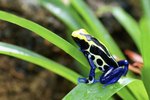
Colorful frogs may be attractive to look at, but don’t you dare touch. These bright jumpers bear toxic skin that can cause complications from mild irritation to death. Despite being found in places as diverse as South America, Africa and Australia, the more than 100 species of poisonous frogs share specific characteristics that make them unique among amphibians.
Poisonous Skin
Poisonous frogs are not venomous -- you do not have to be bitten to be afflicted by their poison. Rather, the frogs’ skin secretes a poison that can cause various reactions when touched. The most poisonous of frogs, such as the Phylobates terribilis, has enough poison on its skin to kill 10 to 12 people. Other poisonous frogs cause numbing or irritation in humans, but can kill or stun small animals and birds.
Poison Through Diet
Poisonous frogs get their secretions from their diet that includes alkaloid-containing ants. The alkaloids are toxic but the frogs have evolved in a way that allows them to store these toxins in sacs in their skin without being poisoned themselves. Frogs hatched in zoos are not poisonous because their diets do not include the alkaloid ants. One exception exists: the corroboree frog of Australia produces its dermal poison itself and is the only invertebrate known to do so.
Diurnal and Habitat
Poison frogs reside mainly in warm humid habitats, such as the rainforests of Central and South America. They can also be found on the African island of Madagascar. With only a few scarce exceptions, poison frogs hop around during the day. Most frog species only come out at night to protect themselves from would-be predators. Poison frogs, however, alert predators through their bright colors and do not need the camouflage of darkness.
Coloring
Poison frogs come in a wide variety of patterns and colors, but most are brighter than non-poisonous frog species. The colors range from brilliant blue to bright yellow to strawberry red. Predators are warned by the colors and markings of the frogs' toxicity and the patterns may help them hide in the shadows.
References
Photo Credits
-
Tom Brakefield/Stockbyte/Getty Images
Writer Bio
Andrea Cespedes is a professionally trained chef who has focused studies in nutrition. With more than 20 years of experience in the fitness industry, she coaches cycling and running and teaches Pilates and yoga. She is an American Council on Exercise-certified personal trainer, RYT-200 and has degrees from Princeton and Columbia University.


